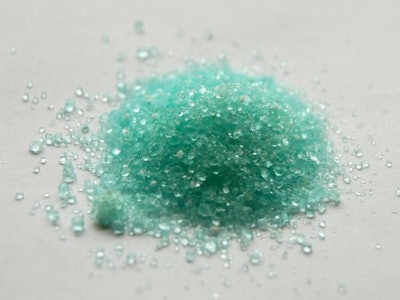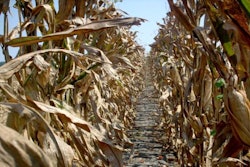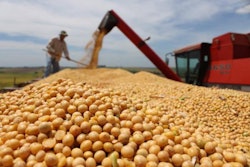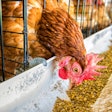
Cottonseed meal could be a less expensive alternative to soybean meal in layer diets if it was not for its main disadvantage: yolk discoloration caused by high gossypol content. It is also quite high in fiber (7 to 20 percent) and rather low in energy content (7 to 8.6 MJ/kg AMEn). Its high protein concentration, however, requires a second look at this interesting alternative ingredient. Crude protein ranges from 36 to 43 percent depending on fiber concentration. In general, the higher the fiber content, the lower the more useful nutrients, such as energy-bearing carbohydrates and lipids, and, of course, protein and amino acids.
The case for gossypol
Gossypol is a yellow pigment found in cottonseed meal. Usually, cottonseed meal contains 1 percent gossypol, but only 0.1 percent is found in free form, the one that is active and problematic. Even though poultry are quite tolerant to this polyphenolic compound, gossypol causes yolk discoloration at levels quite lower than toxic ones. Except for the discoloration, it causes yolks to be viscous or pasty, custard-like. All attributes vary and do not diminish egg nutritive value, but are definitely negative from a consumer point-of-view. Gossypol that causes a green discoloration of the yolk also reduces storage time of eggs, even at low temperatures (5C).
Low gossypol varieties
One way to work around the problem of gossypol is to use cottonseed from cotton varieties known to contain low levels of this undesirable factor. And, as levels can be quite variable, as cottonseeds are sources from many smaller producers all using their own preferred varieties, it pays to analyze for gossypol when receiving a large shipment of cottonseed meal. However, this expense might not be justified, or time from receiving to feeding might not be sufficient to send a sample for analysis.
Ferrous sulfate binds gossypol
One solution to neutralize free gossypol is to add to the diet extra iron that binds to gossypol and reduces its toxicity. In general, it is recommended adding iron at a 1:1 rate to free gossypol. For example, an addition of 0.5 kg ferrous sulphate in a metric ton of feed will neutralize up to 30 ppm of free gossypol. Ferrous sulfate might cause constipation, whereas iron in general favors the growth of iron-thriving bacteria, such as Escerichia coli. Thus, these further complications must be evaluated and addressed by a qualifying nutritionist that can review the complete layer formulas.
Another problem with cottonseed meal is a pinkish hue that can be seen in albumen, usually due to exceptionally high levels of cottonseed meal in the feed. This is caused not by gossypol, but by cyclopropene fatty acids that abound in this ingredient (and also in certain weeds that could possibly contaminate other feed ingredients). Lamentably, this problem cannot be resolved in the same manner as that of gossypol. The only real solution is to limit the inclusion level of offending batches of cottonseed meal down to levels where the problem disappears.
Protein quality
Cottonseed meal is characterized by a remarkably low digestibility of amino acids. Methionine, for example, is only 75 percent digestible in cottonseed meal, whereas it is 91 percent in soybean meal. This disparity makes the use of digestibility cofactors in feed formulation an essential tool in avoiding under-nourishment, especially when high(er) levels of cottonseed are employed. Comparably low levels of digestibility are encountered in all amino acids in cottonseed meal.
Inclusion levels
Despite all the negative discussion so far, cottonseed meal is readily available in many parts of the world and quite often is priced very favorably against soybean meal. Thus, the question, in practical terms, becomes how much cottonseed meal can be used in layer diets — without causing any of the above problems. Assuming feed formulation takes into account the lower amino acid digestibility, and the gossypol issue is controlled, one way or the other, it would be safe to include enough cottonseed up to 30ppm free gossypol in the final feed. With a typical concentration of 0.1 percent or 1,000 ppm free gossypol in most cottonseed meals, this implies a maximum level of 3 percent. Some authorities have a maximum level of 10 percent cottonseed meal but, in my opinion, this is a level that should be reached gradually and with a conservative approach, always evaluating egg interior quality and overall layer performance.
















